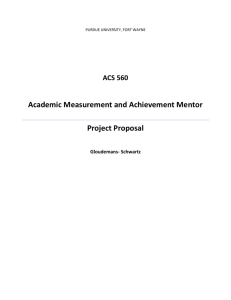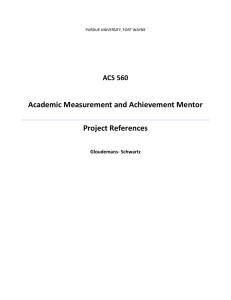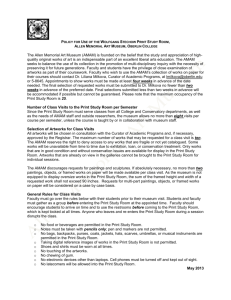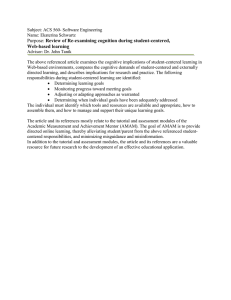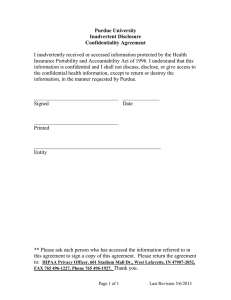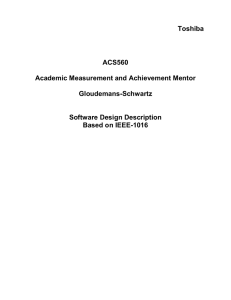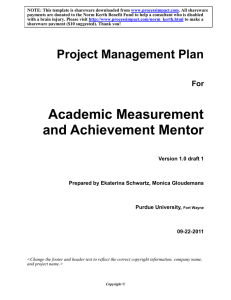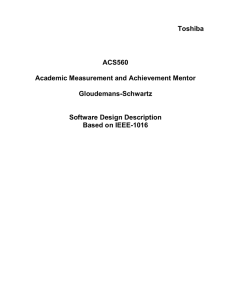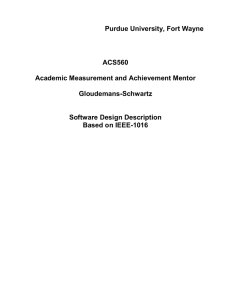Toshiba ACS560 Academic Measurement and Achievement Mentor
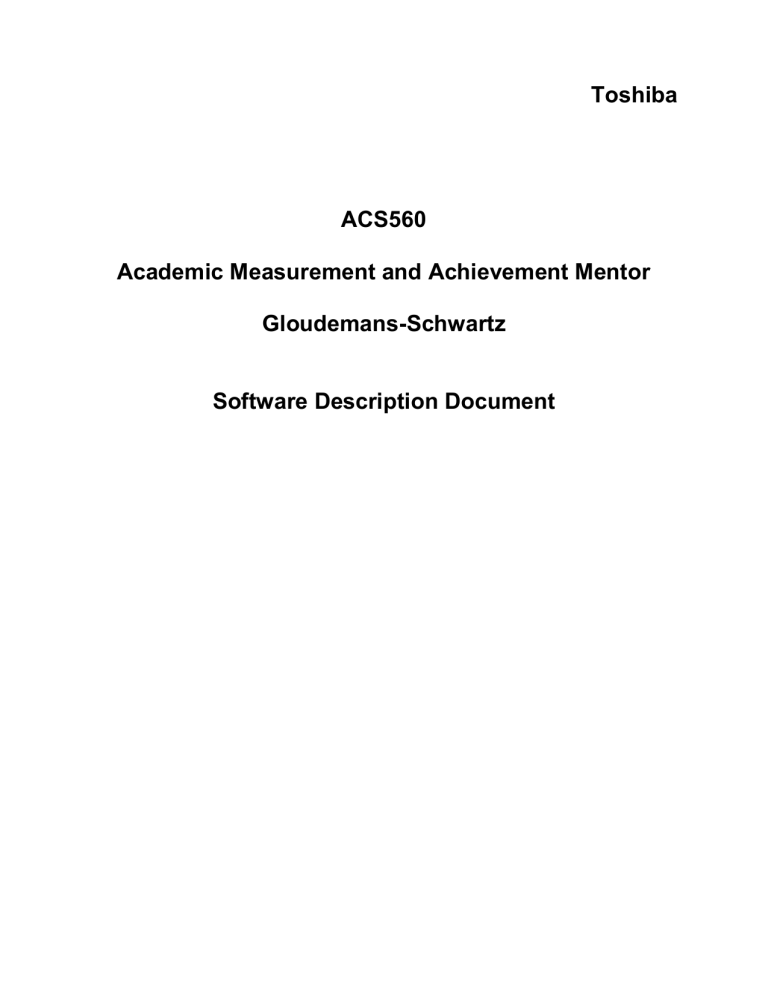
Toshiba
ACS560
Academic Measurement and Achievement Mentor
Gloudemans-Schwartz
Software Description Document
Academic Measurement and Achievement ToolMentor
Software Description Document
Date Version
Revision History
Description
10/24/2011 v0.0 Empty template creation
10/26/2011 v1.0
Version: 1.0
Date: 10/26/2011
Complete Introduction and System
Overview of the SDD
Author
Monica Gloudemans
Ekaterina Schwartz
Monica Gloudemans
Confidential
Purdue University- Fort Wayne 2020 Page 2
Academic Measurement and Achievement ToolMentor
Software Description Document
Table of Contents
Version: 1.0
Date: 10/26/2011
1. Introduction
1.1 Purpose
1.2 Scope
1.3 References
1.4 Overview
1.5 Constraints
2. System Overview
3. System Architecture
3.1 Architectural Description
3.2 Component Decomposition Description
3.3 Architectural Alternatives
3.4 Design Rationale
4. Data Design
4.1 Database Description
4.2 Global Data Structures
4.3 Object-use Description (New Section)
5. Component Design
5.1 Component identifier
5.2 Purpose
5.3 Function
5.4 Subordinates
5.5 Dependencies
5.6 Interfaces
5.7 Data
6. Human Interface Design
6.1 Overview of the User Interface
6.2 Screen Images
6.3 Screen Objects and Actions
6.4 Report Formats
7. Requirements Matrix
8. Resource Estimates
9. Definitions, Acronyms and Abbreviations
Confidential
Purdue University- Fort Wayne 2020 Page 3
16
17
17
17
17
17
17
17
16
16
16
16
12
12
13
16
16
17
17
17
18
18
18
4
4
4
4
4
5
6
18
18
Academic Measurement and Achievement ToolMentor
Software Description Document
Version: 1.0
Date: 10/26/2011
1. Introduction
Provide an overview of the SDD and a description of the scope of the software.
1.1 Purpose
Define the purpose of this SDD and specify intended readership
The purpose of this document is to detail the software requirements related to the Academic
Measurement and Achievement Mentor (AMAM). This document shall describe the purpose of the software along with its capabilities, interfaces, and user interactions. This document is intended for stakeholders, users and the designers of the system. It shall be proposed to the instructor for approval.
1.2
1.3
Scope
Identify the software products to be produced by name; explain what the proposed software will do (and not do, if necessary); describe the relevant benefits, objectives and goals as precisely as possible; and be consistent with related higher-level specifications.
The Academic Measurement and Achievement Mentor is a web-based application that assists students, parents and support persons in assessing and promoting a student’s mastery of the
Indiana state academic standards. Students interact with the web-based Academic
Measurement and Achievement Mentor, through an age-appropriate user interface. The application is accessible wherever an Internet connection is available. Upon registration, initial assessments are conducted in any or all of 4 basic subject areas: English/Language Arts,
Mathematics, Social Studies, and Science. Student assessment results are kept confidential.
Immediate feedback is provided through graphical and textual summaries that associate a proficiency rating with each academic standard. Tutorial resources are linked directly to standards for which the student has demonstrated deficiencies; enrichment resources are linked to standards which the student has mastered. Student assessment is ongoing and iterative with progressive achievement documented and displayed.
References
Provide a complete list of all the applicable and referenced documents.
Academic Measurement and Achievement Mentor, Software Requirements Specification version4.0, October 23, 2011 http://cmapspublic.ihmc.us/rid=1JYMLBN64-22S034X-1D7V/Elaboration%20Phase.cmap
Minimally, a reference to the SRS goes here. If you used any other types of documents to arrive at this design (the Somerville text, documents provided by the client), list them here.
1.4 Overview
Describe what the rest of the SDD contains and explain how the SDD is organized.
Confidential
Purdue University- Fort Wayne 2020 Page 4
Academic Measurement and Achievement ToolMentor
Software Description Document
Version: 1.0
Date: 10/26/2011
This Software Description Document depicts an object-oriented design for the Academic
Measurement and Achievement Mentor (AMAM) application. It provides an overview of
AMAM’s system and a description of its system architecture, data design, component design, human interface design, and requirements. Each of the descriptions listed above is detailed in a section of this document and supplemented with respective diagrams where applicable.
1.5
Constraints
Briefly describe any restrictions, limitations or constraints that impact the design or implementation
Following is a list of constraints that impact the design of the Academic Measurement and
Achievement Mentor:
End-user environment
End-user shall access the AMAM application through the Internet Explorer, Firefox,
Google Chrome, Safari, or Opera internet browsers.
End-user shall interact with the application via a computer terminal, laptop or tablet device running on a Windows 7, Mac OS or UNIX operating system.
End-user shall access application’s video resources in MOV, WMV, or MPG format.
End-User shall access application’s document resources in PDF format.
Availability or volatility of resources
The AMAM shall be designed within the scope of the ACS560 course requirements and tools provided by course instructor.
The AMAM design shall be completed by 12/13/2011.
Standards compliance
The AMAM shall be designed to comply with W3C HTML 4.01 standard.
The AMAM shall be designed to comply with TCP/IP standards.
The AMAM shall be designed to comply with the HTTPS standard.
Interface/protocol requirements
The AMAM shall provide secure user connection by following HTTPS protocol.
AMAM’s web server shall interact with backend applications through application specific interfaces.
Each of AMAM’s backend application shall access database through a database interface.
AMAM’s web services components that provide payment shall interact with the system through the user account interface.
AMAM’s web services component that provides persistent data storage shall interact with the system through the database interface.
Data repository and distribution requirements
The AMAM shall store data in a secure database server.
The AMAM shall implement a external persistent storage
Confidential
Purdue University- Fort Wayne 2020 Page 5
Academic Measurement and Achievement ToolMentor
Software Description Document
Security requirements (or other such regulations)
Version: 1.0
Date: 10/26/2011
The AMAM shall implement Authorization, Authentication, and Session Management.
The AMAM shall implement a secure database connection to a separate database server.
The AMAM shall follow HTTPS protocol for browser-server communication.
Memory and other capacity limitations
AMAM shall require end-user’s system with a minimum of 256MB RAM memory.
Performance requirements
AMAM shall be available 24/7.
AMAM shall operate over 1Mbps internet connection.
AMAM shall support at least 1000 concurrent users making 6 page requests per minute.
AMAM shall have a delay time between a user request and display of the requested resource shall be less than 1 second for 98% of transactions.
Network communications
End-users will require at least 1Mbps speed secure internet connection to access the application stored on the system server.
Web Application Server will require connection to access the secure databases.
2. System Overview
Briefly introduce the system context and design, and discuss the background to the project.
Put context diagram from SRS here to supplement the text.
Confidential
Purdue University- Fort Wayne 2020 Page 6
Academic Measurement and Achievement ToolMentor
Software Description Document
Version: 1.0
Date: 10/26/2011
High stakes testing, a practice in which the outcome on a standardized test is a determining factor in decisions regarding the student, is an area of great concern for both parents and students: underperforming students may be retained at the current grade level for an additional year. The Indiana Statewide Testing for Educational Progress (ISTEP) is administered yearly; however, the results of these tests are not immediately available. Failing test scores may be a parent’s first warning of a child’s deficiencies. Untimely results also permit students to be promoted to the next grade level without mastery of the requisite skills. Since results are not linked to the specific skills associated with each high-level standard, resources are spent reviewing skills for which a student is proficient, at the expense of standards for which the student is truly deficient and in need of remediation. The testing summaries provided by ISTEP are often difficult for parents to access and interpret and are clearly not created for student use.
Classroom teachers are resources for remediation; however, with class sizes increasing and teachers responsible for large numbers of students, appropriate individualized attention may be difficult to obtain.
The Academic Measurement and Achievement Mentor is a web-based application that provides users with proactive tools to assess academic needs and improve student performance to meet mandated academic standards. The AMAM provides assessments that are iterative, feedback that is immediate and remediation that is targeted at specific standards. The application utilizes a database to store student progress information, user-account data, and remediation resources. A customized interface between commercial off-the-shelf e-assessment software and the web application server delivers real-time assessments linked to specific state standards. A report application provides graphical and easy to grasp summaries of student proficiencies and deficiencies linked to resources for enrichment or remediation.
A user (account holder) sets up an AMAM account by completing a registration that requires userID, password, name, and payment services. Once payment services have been completed, the account holder can add students to the account and subsequently modify student information. An Academic Measurement and Achievement Mentor account holder can have multiple students listed in his/her account. Once a student has completed an assessment, the reporting application can be invoked to view results and access remediation resources. Student assessment results are kept confidential. Account information is kept confidential as well.
Figure 1 is a high level use case diagram of the Academic Measurement and Achievement
Mentor showing a collection of typical users and their possible interactions with the system. Not all users can engage in all interactions.
Figure 2 is a use case model of the user-account application from the perspective of a guardian.
Figure 3 is a use case model for a typical student-initiated session with the AMAM system. The session includes an assessment, a review of a report and use of the associated remediation resources.
Figure 4 is an activity diagram of an AMAM session, depicting account holder and student activities.
Confidential
Purdue University- Fort Wayne 2020 Page 7
Academic Measurement and Achievement ToolMentor
Software Description Document
Version: 1.0
Date: 10/26/2011
Figure 1 High Level User Diagram of AMAM
Confidential
Purdue University- Fort Wayne 2020 Page 8
Academic Measurement and Achievement ToolMentor
Software Description Document
Version: 1.0
Date: 10/26/2011
Figure 2 Use Case Model: User-Account Application
Confidential
Purdue University- Fort Wayne 2020 Page 9
Academic Measurement and Achievement ToolMentor
Software Description Document
Version: 1.0
Date: 10/26/2011
Figure 3 Use Case Model: AMAM Student Use
Confidential
Purdue University- Fort Wayne 2020 Page 10
Academic Measurement and Achievement ToolMentor
Software Description Document
Version: 1.0
Date: 10/26/2011
Confidential
Figure 4 Test Session Activity Diagram
Purdue University- Fort Wayne 2020 Page 11
Academic Measurement and Achievement ToolMentor
Software Description Document
3. System Architecture
3.1
Version: 1.0
Date: 10/26/2011
Architectural Description
Develop a modular program structure and explain the relationships between the modules to achieve the complete functionality of the system. This is a high level overview of how Software
Design Document responsibilities of the system were partitioned and then assigned to subsystems. Identify each high level subsystem and the roles or responsibilities assigned to it.
Describe how these subsystems collaborate with each other in order to achieve the desired functionality. Don’t go into too much detail about the individual subsystems. The main purpose is to gain a general understanding of how and why the system was decomposed, and how the individual parts work together. Provide a diagram showing the major subsystems and data repositories and their interconnections. Describe the diagram if required. Include a block diagram showing major subsystems and the interconnections
The AMAM architecture is composed of three major layers: the presentation layer, the application layer and the data layer. The application architecture is depicted in Figure 4. The presentation layer includes components related to the user interface. The user will access the system through a web browser that utilizes plug-in components to enhance the user experience.
Authorization, authentication and session management will be provided through an application framework management system. Further development of this layer is not within the scope of this document. The presentation layer components interface with the application layer through an HTTPS interface.
The application layer includes a web server component and four application components: the tutorial application, the user account application, the assessment application, and the report application. All user requests are processed by the web server, which invokes the appropriate application through an application-specific interface to get the requested resource, dynamically builds a web page, and then delivers the web page to the presentation layer.
The tutorial application component provides basic documentation, videos, and animations related to the use of the AMAM application. The user-account application creates an account for a new user, maintains user preferences, usage data and proficiency profiles. The assessment application builds a test session that is individualized based on the user’s subject choice, standard choice and demonstrated proficiencies. The report application generates individualized reports including assessment results, resources linked to standards for which the individual requires remediation, and overall progress. All of these applications retrieve and update data as required from the system databases.
The data layer includes several databases which maintain user data, content for building standard-linked assessments, remediation and enrichment resources linked to standards. All application layer components interact with the databases through a dedicated database interface. A copy of all information stored in the databases is maintained on a persistent external storage as a backup. Further development of this layer is not within the scope of this document.
Web services used for content management and accounting services interact with the appropriate system databases directly through the database interface. Web services used for payment interact with the system through the user-account interface.
Confidential
Purdue University- Fort Wayne 2020 Page 12
Academic Measurement and Achievement ToolMentor
Software Description Document
Version: 1.0
Date: 10/26/2011
Security is maintained across all layers; further development of the details of security implementation is not within the scope of this document.
Figure 4 Application Architecture
3.2 Component Decomposition Description
Provide a decomposition of the subsystems in the architectural design. Supplement with text
Confidential
Purdue University- Fort Wayne 2020 Page 13
Academic Measurement and Achievement ToolMentor
Software Description Document
Version: 1.0
Date: 10/26/2011 as needed. You may choose to give a functional description or an objectoriented description.
For a functional description, put toplevel data flow diagram (DFD) and structural decomposition diagrams. For an OO description, put subsystem model, object diagrams, generalization hierarchy diagram(s) (if any), aggregation hierarchy diagram(s) (if any), interface specifications, and sequence diagrams here.
Describe the decomposition of the subsystems that summarizes the software components.
Functional – Put data flow diagram (DFD) and structural decomposition diagram here.
OOD – Put object diagrams and aggregation chart here.
Figure 5 Class diagram and aggregation hierarchy: User-account application
Confidential
Purdue University- Fort Wayne 2020 Page 14
Academic Measurement and Achievement ToolMentor
Software Description Document
Version: 1.0
Date: 10/26/2011
Confidential
Figure 6 Class diagram and aggregation hierarchy: Assessment Application
Figure 7 Interface specification diagram To Be added…
Purdue University- Fort Wayne 2020 Page 15
Academic Measurement and Achievement ToolMentor
Software Description Document
3.3 Architectural Alternatives
Discuss other architectures that were considered.
Version: 1.0
Date: 10/26/2011
The 3-tier architecture is a well established model for web-based applications. Due to tight time constraints for the project and the project developers’ lack of experience with other models, alternate architectures were not explored in depth.
3.4 Design Rationale
Discuss the rationale for selecting the architecture described in 3.1, including the critical issues and trade/offs that were considered. You may discuss other architectures that were considered, provided that you explain why you didn’t choose them.
A 3-tier architecture was chosen to facilitate upgrades to the system. The modular design allows individual components to be swapped in and out of the system independently of other layers and components. For the initial implementation of the AMAM system, commercial off-the-shelf components will be used for the report application and parts of the assessment application.
These components are likely to be replaced or upgraded as assessment technologies improve.
4. Data Design
Explain how the information domain of your system is transformed into data structures.
Describe how the major data or system entities are stored, processed and organized. List any databases or data storage items.
4.1 Database Description
Describe the database(s) which is/are part of the system.
4.2 Global Data Structures
Describe any data structures that are a major part of this system.
This should include major data structures that are passed between components. That is, it is not restricted to truly “global” data structures.
4.3 Object-use Description (New Section)
Functional – Put data dictionary here and call the section Data Dictionary. Refer the reader to the structural decomposition diagram in Section 3.2.
If you provided an OO description, list the objects and its attributes, methods and method parameters.
OOD – Put object-use description diagrams here and call the section Object-use Description
Diagrams. Refer the reader to the object diagrams in Section 3.2.
5. Component Design
In this section, we take a closer look at what each component does in a more systematic way. If Software Design
Document you gave a functional description in section 3.2, provide a summary of your algorithm for each function listed in 3.2 in procedural description language (PDL) or pseudocode. If you gave an
OO description, summarize each object member function for all the objects listed in 3.2 in PDL or pseudocode.
Describe any local data when necessary.
Confidential
Purdue University- Fort Wayne 2020 Page 16
Academic Measurement and Achievement ToolMentor
Software Description Document
Include a top-down description of the design components.
Version: 1.0
Date: 10/26/2011
Functional – Put the function mini-specs (PDL descriptions) here. Relate them to the structural decomposition diagram in Section 3.2.
OOD – Put the PDL for the object member functions here. Relate them to the object diagrams in Section 3.2.
You may want to reorganize this section (5.1 – 5.7) to make it flow better. That is fine as long as all of the information below is presented in some manner.
5.1 Component identifier
Assign a unique identifier for use throughout the SDD.
5.2
5.3
Purpose
A reference back to the requirements spec.
Function
What does the component do? Describe its processing.
5.4
5.5
5.6
5.7
Subordinates
The components used by this component.
Dependencies
Constraints placed on this component by other components.
Interfaces
Control and data flow into and out of the component.
Data
Descriptions of internal data
6. Human Interface Design
6.1 Overview of the User Interface
Describe the functionality of the system from the user’s perspective. Explain how the user will be able to use your system to complete all the expected features and the feedback information that will be displayed for the user.
Describe the general functionality of the system from the user’s perspective.
6.2 Screen Images
Display screenshots showing the interface from the user’s perspective. These can be handdrawn or you can use an automated drawing tool. Just make them as accurate as possible.
(Graph paper works well.)
Include screenshots showing the interface from the user’s perspective.
Confidential
Purdue University- Fort Wayne 2020 Page 17
Academic Measurement and Achievement ToolMentor
Software Description Document
6.3 Screen Objects and Actions
Version: 1.0
Date: 10/26/2011
A discussion of screen objects and actions associated with those objects.
6.4 Report Formats
Include a description of major reports provided by the system.
7. Requirements Matrix
Provide a cross reference that traces components and data structures to the requirements.
Use a tabular format to show which system components satisfy each of the functional requirements from the SRS. Refer to the functional requirements by the numbers/codes that
you gave them in the SRS.
8. Resource Estimates
A summary of computer resource estimates required for operating the software.
9. Definitions, Acronyms and Abbreviations
Term
Provide definitions of all terms, acronyms and abbreviations needed for the SDD.
Adaptive test
AMAM
Assessment application
Content management e-Assessment
Definition
A test that successively selects questions so as to maximize the precision of the exam based on what is known about the examinee from previous questions.
Academic Measurement and Achievement Tool
A component of the AMAM which builds e-assessments.
Indiana State
Academic Standards
ISTEP
Item bank
Plug-in
Proficiency profile
Remediation resource
Report application
SDD
SRS
User
User-account
The set of processes and technologies that support the collection and management of the remediation resources, academic standards and assessment item bank.
The use of computers and computer software to evaluate skills and knowledge in a certain area. For the AMAM, e- Assessment consists primarily of on-screen testing systems.
Standards outline what students should know and be able to do at each grade level as defined by the Indiana Department of Education. http://dc.doe.in.gov/Standards/AcademicStandards/PrintLibrary/index.shtml
Indiana Statewide Testing for Educational Progress
A collection of test questions and answers.
A set of software components that adds specific abilities to a larger software application enabling the customization of the functionality of an application.
A numerical snapshot of a student’s strengths and weaknesses for each skill in the
Indiana academic state standards.
A web-link to a video, tutorial, game, or instructional activity that aims to improve a student’s mastery of an academic standard.
A component of the AMAM which creates summary reports.
Software Description Document
Software Requirements Specification
Student, parent or support staff or any other person who interacts with the AMAM.
A component of the AMAM which builds user accounts.
Confidential
Purdue University- Fort Wayne 2020 Page 18
Academic Measurement and Achievement ToolMentor
Software Description Document application
WAS
Web browser
Version: 1.0
Date: 10/26/2011
Web application server which utilizes the AMAM application components to build rich, user-specific web pages.
A web browser is a program designed to enable users to access, retrieve and view documents and other resources on the Internet.
Confidential
Purdue University- Fort Wayne 2020 Page 19
